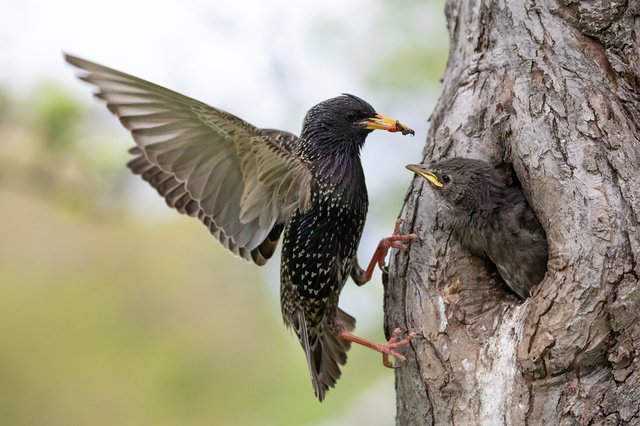
Females sing more than thought: about the structure of the brain of birds – the science
The more birds that sing, the more their brains change.
Birds sing more in the spring than in the rest of the year. Before the breeding season, they must attract a mate and defend the area. Neurobiologist Anemi van der Linden (UAntwerp) and her colleagues demonstrate that the structure of songbirds’ brains changes over the course of a year. in the magazine eLife They reported that the more animals sing, the more their brains changed.
Moreover, this occurs not only in the areas of the brain associated with singing, but also in the areas responsible for sight and hearing. Changes occur very quickly until spring.
It was intriguing to discover that female birds sing more than many biologists assume. Their brains change, too, but differently than the brains of males. In male starlings, the hemisphere responsible for the song is denser than in the other, but in females there are stronger connections between the two hemispheres. A similar difference also occurs in humans.
Biologist Erich Matessen (UAntwerp) records with a number of colleagues Proceedings of the National Academy of Sciences The nature of birds is determined in part by place and time. Some great boobs are bold, others are wary. The distinction is hereditary, but the balance between both types in the population changes due to local conditions. In years or places where there is less food, daredevils have an advantage, because they will find new food sources more easily. If there is enough food, it is enough to be routine – this is more suitable for energy.
The nature of the birds is determined in part by local conditions.
Birds sing more in the spring than in the rest of the year. Before the breeding season, they must attract a mate and defend the area. Neurobiologist Anemi van der Linden (UAntwerp) and her colleagues demonstrate that the structure of songbirds’ brains changes over the course of a year. In the trade journal eLife, they report that the more the animals sang, the more their brains changed. Moreover, this occurs not only in the areas of the brain associated with singing, but also in the areas responsible for sight and hearing. Changes occur very quickly until spring. It was intriguing to discover that female birds sing more than many biologists assume. Their brains change, too, but differently than the brains of males. In male starlings, the hemisphere responsible for the song is denser than in the other, but in females there are stronger connections between the two hemispheres. A similar difference also occurs in humans. Biologist Eric Matissen (UAntwerp) and several colleagues write in the Proceedings of the National Academy of Sciences that bird personality is determined in part by space and time. Some big boobs are bold, others are wary. The distinction is hereditary, but the balance between both types in the population changes due to local conditions. In years or places where there is less food, daredevils have an advantage, because they will find new food sources more easily. If there is enough food, it is enough to be routine – this is more suitable for energy.

Baby birds can learn sounds before birth
A new study led by the BirdLab research group at Flinders University discovered evidence of prenatal auditory learning in embryos of five bird species. Using non-invasive techniques, researchers found fluctuations in heartbeat responses to their parents’ calls in the embryos of three vocal learning species (the superb fairy-wren, the red-winged fairy-wren, and Darwin’s small ground finch), as well as two vocal non-learning species (the little penguin and the Japanese quail).
“By studying the capacity for sound learning in embryos, we are paving the way to new inroads into evolutionary and developmental timescales,” said study first author Dr. Diane Colombelli-Négrel. “Long before actual vocalization, we found that these tiny songbirds were also discriminating towards non-specific sounds and capable of ‘non-associative’ (not from parents) sounds, building on the complexity of vocal learning in songbirds.”
According to study co-author Professor Sonia Kleindorfer, vocal production learning is believed to occur in just seven lineages of birds and mammals: songbirds, hummingbirds, parrots, cetaceans, pinnipeds, bats, and, among primates, only humans.
“As a result of the rarity of vocal production learning, animals have been grouped into so-called ‘vocal learners’ (those that learn to imitate a vocalisation from a vocal tutor) and ‘vocal non-learners’ (animals that produce vocalisations without imitating a vocal tutor),” explained Professor Kleindorfer.
Surprisingly though, this new study found that embryos could grow accustomed to another bird’s call in both vocal learning and non-learning species, and may thus point to a phenomenon more widespread than initially thought.
“This research will hopefully inspire more study into the remarkable capacity of animals to learn sound,” said Professor Kleindorfer. “By moving the time window for sound learning to the prenatal stage, this research direction opens pathways to measure neurobiological downstream effects of early auditory experience on behaviour and information processing.”
The research is published in the journal Philosophical Transactions of the Royal Society B.
—
By Andrei Ionescu, Earth.com Staff Writer
No comments:
Post a Comment